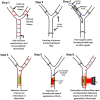Nanogold-coated stent facilitated non-invasive photothermal ablation of stent thrombosis and restoration of blood flow
- PMID: 38419863
- PMCID: PMC10898437
- DOI: 10.1039/d3na00751k
Nanogold-coated stent facilitated non-invasive photothermal ablation of stent thrombosis and restoration of blood flow
Abstract
In-stent restenosis (ISR) and stent thrombosis (ST) are the most serious complications of coronary angioplasty and stenting. Although the evolution of drug-eluting stents (DES) has significantly restricted the incidence of ISR, they are associated with an enhanced risk of ST. In the present study, we explore the photothermal ablation of a thrombus using a nano-enhanced thermogenic stent (NETS) as a modality for revascularization following ST. The photothermal activity of NETS, fabricated by coating bare metal stents with gold nanorods generating a thin plasmonic film of gold, was found to be effective in rarefying clots formed within the stent lumen in various in vitro assays including those under conditions mimicking blood flow. NETS implanted in the rat common carotid artery generated heat following exposure to a NIR-laser that led to effective restoration of blood flow within the occluded vessel in a model of ferric chloride-induced thrombosis. Our results present a proof-of-concept for a novel photothermal ablation approach by employing coated stents in the non-invasive management of ST.
This journal is © The Royal Society of Chemistry.
Conflict of interest statement
The authors declare no competing interests.
Figures






Similar articles
-
Intravascular ultrasound to guide percutaneous coronary interventions: an evidence-based analysis.Ont Health Technol Assess Ser. 2006;6(12):1-97. Epub 2006 Apr 1. Ont Health Technol Assess Ser. 2006. PMID: 23074482 Free PMC article.
-
Everolimus-Eluting Stents in Patients With Bare-Metal and Drug-Eluting In-Stent Restenosis: Results From a Patient-Level Pooled Analysis of the RIBS IV and V Trials.Circ Cardiovasc Interv. 2016 Jul;9(7):e003479. doi: 10.1161/CIRCINTERVENTIONS.115.003479. Circ Cardiovasc Interv. 2016. PMID: 27412868
-
Contemporary treatment of in-stent restenosis and the incidence of recurrent in-stent restenosis in the era of drug-eluting stents.Heart Lung Circ. 2007 Aug;16(4):269-73. doi: 10.1016/j.hlc.2007.02.089. Epub 2007 Apr 6. Heart Lung Circ. 2007. PMID: 17419097
-
Clinical Outcomes of Drug-Eluting versus Bare-Metal In-Stent Restenosis after the Treatment of Drug-Eluting Stent or Drug-Eluting Balloon: A Systematic Review and Meta-Analysis.J Interv Cardiol. 2020 Jun 26;2020:8179849. doi: 10.1155/2020/8179849. eCollection 2020. J Interv Cardiol. 2020. PMID: 32684867 Free PMC article.
-
Stent thrombosis with drug-eluting stents: is the paradigm shifting?J Am Coll Cardiol. 2013 Nov 19;62(21):1915-1921. doi: 10.1016/j.jacc.2013.08.725. Epub 2013 Sep 11. J Am Coll Cardiol. 2013. PMID: 24036025 Review.
References
-
- WHO, Cardiovascular diseases, https://www.who.int/health-topics/cardiovascular-diseases#tab=tab_1
-
- CDC, Heart Disease Deaths Vary by Sex, Race, and Ethnicity, https://www.cdc.gov/heartdisease/facts.htm#:∼:text=HeartDiseaseintheUnit...
LinkOut - more resources
Full Text Sources
Miscellaneous

